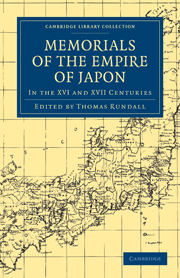Summary
In the year 1608, Don Rodrigo de Vivero y Velasco, the Governor General of the Philippines, was shipwrecked on his return to Spain, and cast upon the coast of Japan.
Don Rodrigo's vessel struck upon a reef off the coast of Niphon, in about latitude 35½°: the crew, with himself, reached the shore on parts of the wreck totally destitute, and not knowing where they were cast, whether on a continent or an island. They soon found the country to be Japan; and as Don Rodrigo had shown much kindness to two hundred natives of that country, in confinement in the Philippine islands when he became governor, whom he liberated and conveyed home, he concluded that, as the event proved, the emperor would avail himself of the opportunity to requite the obligation.
Amongst the crew of the Spanish vessel was a Japanese Christian, who soon discovered that they were near a small village called Yu Banda, whither they proceeded. It contained about 1,500 inhabitants, and was dependent upon one of the inferior nobles, who, nevertheless, had many vassals, several towns and villages, and lived in a strong fortress. The people of the village, when they learned the disaster of the party, evinced much compassion, and the females shed tears. They gave them clothing and food (consisting of rice, pulse, and a little fish), and sent word to the tono, or lord, who desired that the party might be well treated, but not suffered to remove.
- Type
- Chapter
- Information
- Memorials of the Empire of JaponIn the XVI and XVII Centuries, pp. 171 - 186Publisher: Cambridge University PressPrint publication year: 2010First published in: 1850

